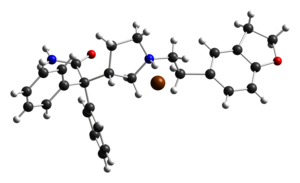Darifenacin
 | |
 | |
| Names | |
|---|---|
| Trade names | Enablex, Emselex, others |
| |
| Clinical data | |
| Drug class | Anticholinergic[1] |
| Main uses | Overactive bladder[2] |
| Side effects | Dry mouth, constipation[2] |
| Pregnancy category |
|
| Routes of use | By mouth |
| External links | |
| AHFS/Drugs.com | Monograph |
| MedlinePlus | a605039 |
| Legal | |
| Legal status | |
| Pharmacokinetics | |
| Bioavailability | 15 to 19% (dose-dependent) |
| Protein binding | 98% |
| Metabolism | Liver (CYP2D6- and CYP3A4-mediated) |
| Elimination half-life | 13 to 19 hours |
| Excretion | Kidney (60%) and biliary (40%) |
| Chemical and physical data | |
| Formula | C28H30N2O2 |
| Molar mass | 426.560 g·mol−1 |
| 3D model (JSmol) | |
| |
| |
Darifenacin, sold under the trade name Enablex among others, is a medication used to treat overactive bladder.[2] It is taken once per day by mouth.[2] Benefits are generally seen within 2 weeks.[2]
Common side effects include dry mouth and constipation.[2] Other side effects may include cough, bladder pain, blurry vision, urinary retention, shortness of breath, sexual dysfunction, and high blood pressure.[2][3] Use is not recommended during pregnancy.[3] It is an anticholinergic which helps the bladder relax.[1]
Darifenacin was approved for medical use in the United States and Europe in 2004.[2][1] It is available as a generic medication.[4] In the United States it costs about 37 USD per month as of 2021.[4] This amount in the United Kingdom costs the NHS about £25.[3]
Medical uses
Darifenacin is indicated for the treatment of overactive bladder with symptoms of urge urinary incontinence, urgency and frequency in adults. It may also be recommended with an alpha blocker to help provide symptomatic benefit for overactive bladder and obstructive symptoms such as likely associated with benign prostatic hypertrophy. [5]
Dosage
The typically dose is 7.5 to 15 mg once per day.[2]
Side effects
Darifenacin should not be used in people with urinary retention. Anticholinergic agents, such as darifenacin, may also produce constipation and blurred vision. Heat prostration (due to decreased sweating) can occur when anticholinergics such as darifenacin are used in a hot environment.[6]
Mechanism of action
Darifenacin works by blocking the M3 muscarinic acetylcholine receptor, which is primarily responsible for bladder muscle contractions. It thereby decreases the urgency to urinate. It is not known whether this selectivity for the M3 receptor translates into any clinical advantage when treating symptoms of overactive bladder syndrome.[6]
History
It was discovered by scientists at the Pfizer research site in Sandwich, UK under the identifier UK-88,525 and used to be marketed by Novartis. In 2010, the US rights were sold to Warner Chilcott for US$400 million.
References
- ↑ 1.0 1.1 1.2 "Emselex". Archived from the original on 10 January 2021. Retrieved 21 July 2021.
- ↑ 2.0 2.1 2.2 2.3 2.4 2.5 2.6 2.7 2.8 "Darifenacin Monograph for Professionals". Drugs.com. Archived from the original on 18 January 2021. Retrieved 21 July 2021.
- ↑ 3.0 3.1 3.2 BNF (80 ed.). BMJ Group and the Pharmaceutical Press. September 2020 – March 2021. p. 821. ISBN 978-0-85711-369-6.
{{cite book}}: CS1 maint: date format (link) - ↑ 4.0 4.1 "Darifenacin ER Prices, Coupons & Savings Tips - GoodRx". GoodRx. Archived from the original on 4 July 2016. Retrieved 21 July 2021.
- ↑ American Urological Association (AUA) Guideline. Diagnosis and Treatment of Overactive Bladder in Adults: AUA/SUFA guideline 2012
- ↑ 6.0 6.1 "Enablex- darifenacin tablet, extended release". DailyMed. 24 September 2016. Archived from the original on 26 October 2020. Retrieved 22 October 2020.
External links
| External sites: | |
|---|---|
| Identifiers: |
|
- "Darifenacin hydrobromide". Drug Information Portal. U.S. National Library of Medicine. Archived from the original on 2020-10-26. Retrieved 2020-11-25.
- Pages using duplicate arguments in template calls
- Pages with non-numeric formatnum arguments
- CS1 maint: date format
- Drugs with non-standard legal status
- Chemical articles with unknown parameter in Infobox drug
- Chemical articles without CAS registry number
- Articles without EBI source
- Chemical pages without ChemSpiderID
- Chemical pages without DrugBank identifier
- Articles without KEGG source
- Articles without UNII source
- Chemicals using indexlabels
- Drugs missing an ATC code
- Drugboxes which contain changes to verified fields
- Drugboxes which contain changes to watched fields
- Articles with changed KEGG identifier
- Muscarinic antagonists
- 5-Benzofuranethanamines
- Carboxamides
- AbbVie brands
- Novartis brands
- Pyrrolidines
- Benzhydryl compounds
- RTT